
by Samantha Kennedy | Nov 15, 2024
Maintaining a healthy diet can be challenging, especially for individuals managing high blood sugar levels. Choosing the right snacks is crucial for avoiding blood sugar spikes and keeping energy levels stable throughout the day. Here, we explore several healthy snack options that are both delicious and beneficial for those with high blood sugar.
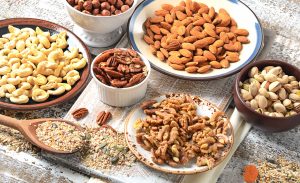
Snacks high in protein, fiber, and healthy fats such as nuts and seeds are a healthy choice for people looking to manage their high blood sugar. (Source: Adobe Stock photo)
Nuts and seeds. These foods are excellent snacks for people with high blood sugar. Almonds, walnuts, flaxseeds, and chia seeds are rich in fiber, healthy fats, and protein, which help stabilize blood sugar levels. A handful of almonds or a tablespoon of chia seeds in a smoothie can keep you feeling full and satisfied without causing a spike in blood sugar. Additionally, these snacks are packed with vitamins and minerals that contribute to overall health.
Fresh vegetables. Foods like carrots, celery, and bell peppers are low in calories and carbohydrates, making them ideal for blood sugar management. These veggies are high in fiber and water content, which help in maintaining a feeling of fullness. Pairing them with hummus or a Greek yogurt dip adds protein and flavor, creating a balanced and tasty snack option.
Berries. Foods such as strawberries, blueberries, and raspberries are not only delicious but also have a low glycemic index, meaning they do not cause significant spikes in blood sugar. Rich in antioxidants, vitamins, and fiber, a small bowl of mixed berries can be a satisfying snack. For added protein, consider combining them with a small portion of Greek yogurt or cottage cheese.
Whole-grain crackers and avocado. This combination provides a perfect balance of complex carbohydrates, healthy fats, and fiber. Whole grains help slow digestion, preventing sudden increases in blood sugar levels, while avocados offer monounsaturated fats that are heart-healthy and satisfying. Sprinkle some chia or sesame seeds on top for an extra nutritional boost.
Greek yogurt. This very versatile snack is high in protein and lower in sugar compared to regular yogurt. It is an excellent option for people with high blood sugar, as protein can help slow the absorption of carbohydrates, thereby preventing spikes. For a more filling snack, add a handful of nuts or fresh berries to a cup of Greek yogurt.
Hard-boiled eggs. This is a simple and convenient snack option packed with high-quality protein and healthy fats. They can help stabilize blood sugar levels and keep hunger at bay. Sprinkle a little salt and pepper or enjoy them with a side of fresh veggies for a complete snack.
Edamame. Also known as steamed soybeans, these are an excellent snack choice for those managing high blood sugar. They are high in protein, fiber, and essential vitamins and minerals. A half-cup serving of edamame provides a satisfying and nutritious snack that supports blood sugar control.
For individuals with high blood sugar, mindful snacking is essential to maintaining stable glucose levels and overall health. By choosing nutrient-dense, low-glycemic snacks such as nuts, fresh vegetables, berries, whole grains, Greek yogurt, hard-boiled eggs, and edamame, it is possible to enjoy delicious and satisfying snacks without compromising blood sugar control. Incorporating these healthy options into your daily routine can make a significant difference in managing high blood sugar effectively.
For more information about healthy eating for people with or without high blood sugar, please contact Samantha Kennedy, County Extension Director, at 850.926.3931.
An Equal Opportunity Institution.

by Angela Hinkle | Jan 24, 2020
My favorite time – snack time! For February, National Snack Food Month, let’s celebrate these tasty morsels for a whole month.
Go Beyond the Snack Aisle
Snacks often have a bad reputation, at least in terms of health. It’s true that snack food aisles are often filled with high fat, high calorie, high sodium, and high sugar choices. But snacks can be great sources of fiber, vitamins, minerals, proteins, and healthier fats and carbohydrates. You may just have to wander to other parts of the store next time you shop.
Think Mini Meal
When you snack, think of it as a mini meal. Though you could plan tomorrow’s dinner to be a plate of snack cakes with a side of potato chips, hopefully you come up with something more satisfying than that – both in taste and nutrition. Additionally, when we snack on healthier foods in between meals, it gives our bodies the sustainable energy it needs to make it to that next meal.
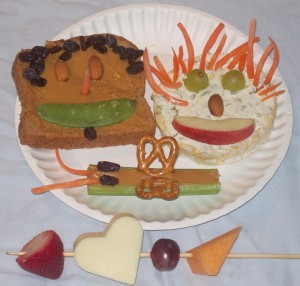
Snacks – Fun, Tasty, and Healthy
Photo Source: Angela Hinkle
Snack MyPlate
Try snacking from all five food groups this month.
- Whole grains – popcorn, granola, whole grain crackers
- Fruits – apples, bananas, oranges, raisins
- Veggies – pea pods, cucumber slices, carrots
- Dairy – string cheese, yogurt cups, individual shelf stable cartons of milk
- Protein – hard-boiled eggs, mixed nuts, healthy beef jerky
Make Homemade Mixed-Up Food Group Snacks
- Whole grain pita or multi-colored pepper slices dipped in guacamole or hummus
- Apple slices or carrots with peanut butter dip
- Cherry tomatoes with mozzarella and basil
- Fruit smoothies or protein shakes
- Yogurt with granola and mixed berries
- Banana Sushi – smear a whole wheat tortilla with peanut butter, put a banana in the middle, roll it up, then cut it into “sushi” slices
For more great snacking ideas, check out 10 Snack Tips for Parents, MyPlate Snack Tips for Kids, and 25 Healthy Snacks for Kids
Delicious, healthy, on-the-go snacks. Be creative and keep it healthy this February – National Snack Food month.
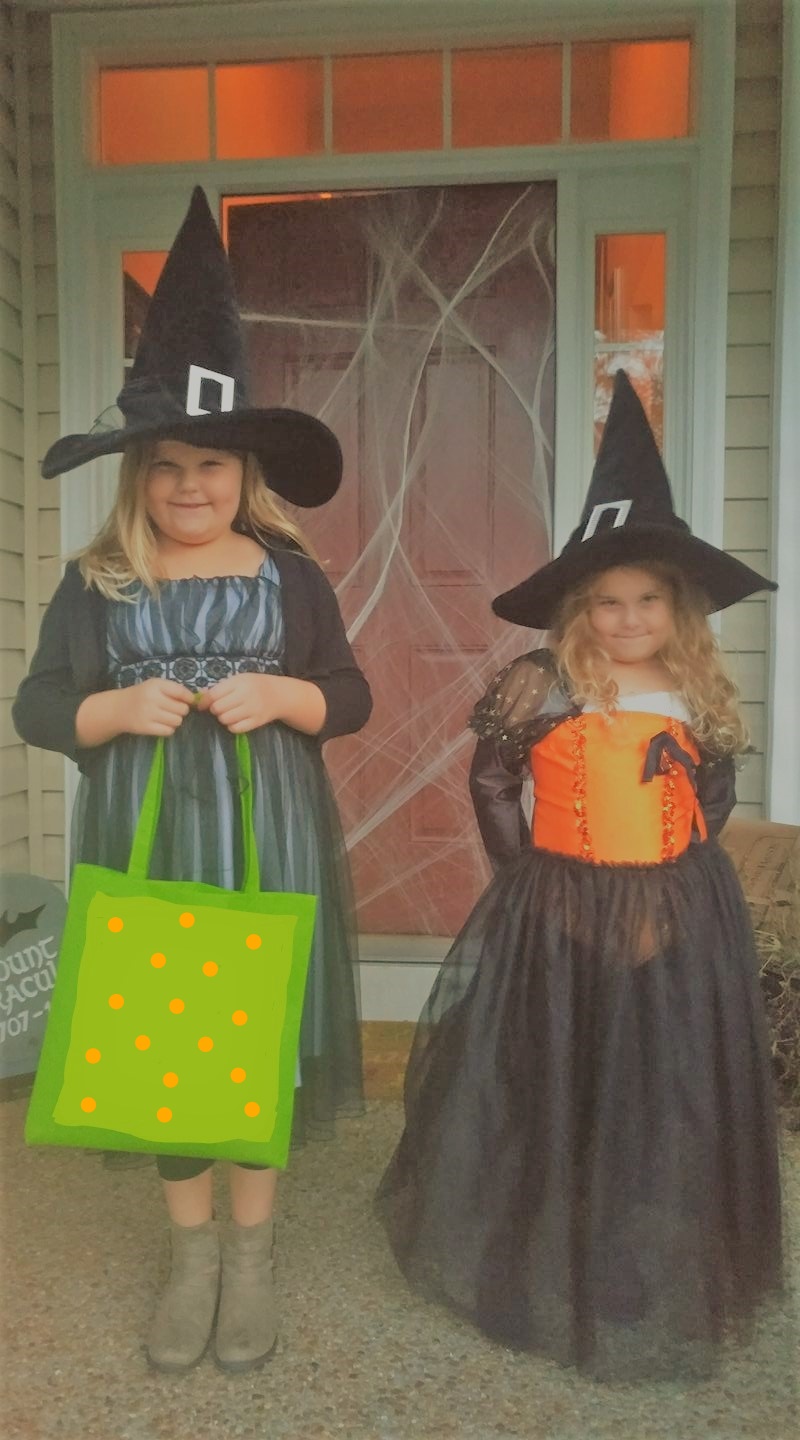
by Melanie Taylor | Oct 16, 2017

Make Halloween a fun and safe night for children and adults alike.
From candy to pumpkins to the costumes, Halloween is a fun-filled time for kids and adults alike. However, it can pose dangers. To help make this year’s trick-or-treat a safe and fun time, follow these simple safety tips compiled by the American Academy of Pediatrics.
CREATIVE COSTUMES:
Plan costumes that are bright and reflective. Make sure shoes fit well and costumes are short enough to prevent tripping, entanglement, or contact with flames.
Consider adding reflective tape or striping to costumes and trick-or-treat bags for greater visibility.
Because masks can limit or block eyesight, consider non-toxic makeup and decorative hats as safer alternatives. Hats should fit properly to prevent them from sliding over eyes. The makeup should be tested on a small patch of skin ahead of time to ensure there are no unpleasant allergies on the big night.
When shopping for costumes, wigs, and accessories, look for and purchase those with a label clearly indicating they are “flame resistant.”
If a sword, cane, or stick is a part of your child’s costume, make sure it is not sharp or long. A child may be easily hurt by the accessories if he/she stumbles or trips.
Do not use decorative contact lenses without an eye examination and a prescription from an eye care professional. While the packaging on decorative lenses will often make claims such as “one size fits all,” or “no need to see an eye specialist,” obtaining decorative contact lenses without a prescription is both dangerous and illegal. This can cause pain, inflammation, and serious eye disorders and infections, which may lead to permanent vision loss.
Review with children how to call 911 if they ever have an emergency or become lost.
PUMPKIN CARVING TIME:
Small children should never carve pumpkins. Children can draw a face with markers. Then adults can do the cutting.
Consider using a flashlight or glow stick instead of a candle to light your pumpkin. If you do use a candle, a votive candle is safest.
Candlelit pumpkins should be placed on a sturdy table, away from curtains and other flammable objects, and not on a porch or any path where visitors may pass close by. They should never be left unattended.
HOME SAFETY:
To keep homes safe for visiting trick-or-treaters, parents should remove from the porch and front yard anything a child could trip over such as garden hoses, toys, bikes, and lawn decorations.
Adults should check outdoor lights and replace burned-out bulbs.
Wet leaves and debris should be swept from sidewalks and steps.
Restrain pets so they do not jump on or bite a trick-or-treater.
TRICK-OR-TREAT TIME:
A responsible adult should always accompany young children during their neighborhood trick-or-treating.
Obtain flashlights with fresh batteries for all children and adults.
If your older children are going alone, plan and review the route that is acceptable to you. Agree on a specific time when they should return home.
Only go to homes with a porch light on and never enter a home or car for a treat.
Because pedestrian injuries are the most common injuries to children on Halloween, remind Trick-or-Treaters to:
- Stay in a group and communicate where they will be going.
- Remember reflective tape for costumes and trick-or-treat bags.
- Carry a cellphone for quick communication.
- Remain on well-lit streets and always use the sidewalk.
- If no sidewalk is available, walk at the far edge of the roadway facing traffic.
- Never cut across yards or use alleys.
- Only cross the street as a group in established crosswalks (as recognized by local custom). Never cross between parked cars or out of driveways.
- Do not assume the right of way. Motorists may have a hard time seeing Trick-or-Treaters.
- Just because one car stops does not mean others will!
- Law enforcement authorities should be notified immediately of any suspicious or unlawful activity.
HEALTHY HALLOWEEN TIPS:
A good, healthy dinner prior to parties and trick-or-treating will discourage children from filling up on Halloween treats.
Consider purchasing non-food treats for those who visit your home, such as coloring books, stickers, or pens and pencils.
Wait until children are home to sort and check treats. Though tampering is rare, a responsible adult should closely examine all treats and throw away any spoiled, unwrapped or suspicious items.
Try to ration treats for the days and weeks following Halloween to prevent overindulging, which will lead to a stomachache and ruin the night’s fun.
Make sure the Halloween night is fun and safe with the suggested tips above. These tips will help guarantee you all a ghoulishly good time.
Source: American Academy of Pediatrics
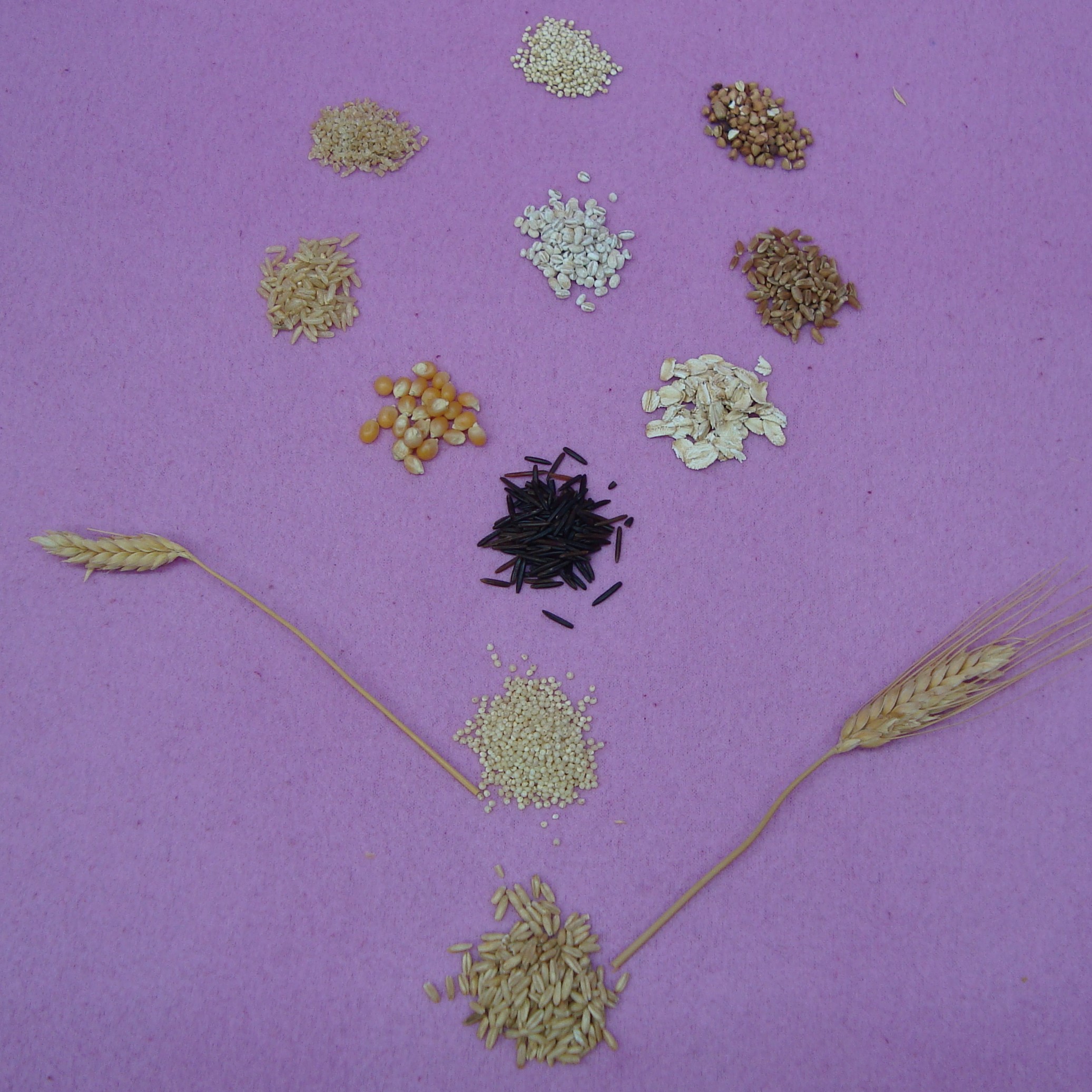
by Angela Hinkle | Apr 2, 2017
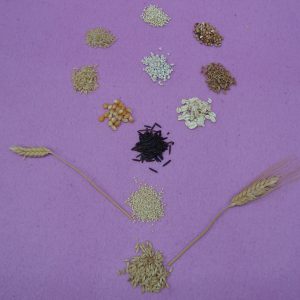 Wedding showers, baby showers, graduation parties – let’s face it, about half the celebration is based on the food that is served. Trays and plates of tasty morsels include a variety of colors, textures, sizes, and tastes. Why not include some healthy, whole grain options to join in on the fun?
Wedding showers, baby showers, graduation parties – let’s face it, about half the celebration is based on the food that is served. Trays and plates of tasty morsels include a variety of colors, textures, sizes, and tastes. Why not include some healthy, whole grain options to join in on the fun?
Whole grain foods contain the whole edible part of the plant – the bran, endosperm, and germ. Consuming whole grains offers many health benefits like reducing risk of heart disease, type 2 diabetes, and some cancers. Look for 100% whole grain on a package or “whole” as the first item in the ingredient list. Think of whole grain party foods as an extra “present” to give new moms, graduates, and engaged couples a healthy boost.
Try serving whole grain crackers topped with your favorite cheese and herb, whole grain pancakes or French toast with fruit, oatmeal cookies, ham and grainy mustard on mini whole grain rolls, finger sandwiches on whole grain bread cut into festive shapes, or popcorn (a whole grain) with a dash of chili powder, cumin, and garlic. Click kingarthurflour for even more whole grain party ideas.
Here’s a light spring side salad with a whole grain sure to please guests at your next shower.
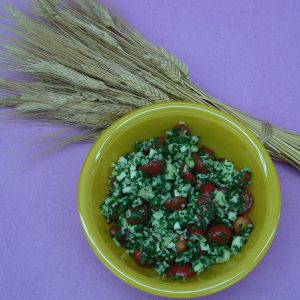
Spring Grain Salad
1 Cup cooked brown or wild rice or whole grain barley, bulgur, couscous, or other grain
6 Cups spinach or kale, stems removed
1/4 Teaspoon each salt and pepper
1/4 Cup fresh mint leaves
1/3 Cup lemon juice
1/4 Cup olive oil
1 Garlic clove, finely chopped
1 Pint grape or cherry tomatoes, halved
1/2 Chopped cucumber (preferably seedless)
3/4 Cup mozzarella cheese, small dice (optional)
- In a food processor, combine the spinach and mint and process until finely chopped, scraping down sides of the bowl, if necessary.
- In a large bowl, whisk together the lemon juice, oil, garlic, salt, and pepper. Add the whole grain of choice, spinach mixture, tomatoes, cucumber, and cheese. Toss to combine.
To incorporate whole grains into your shower days and every day, go to MakeHalfYourGrainsWhole.
And the next time you get the whole gang together, go whole grain!
by Laurie Osgood | Feb 14, 2017
February has been designated National Snack Month by the Snack Food Association of America, and the National Potato Promotion Board.
As Americans, the one thing that we can all agree on is our love of snacks. Snack sales in the United States top $60 Billion annually. The snack foods that we tend to reach for can be loaded with calories, sugar, sodium and fat. However, snack foods do not have to be unhealthy to satisfy your cravings. When you need a little boost of energy during the day, a healthy snack can do the trick.
According to University of Florida’s Karla Shelnutt, Associate Professor and Extension Nutrition Specialist, and Julie Martinez, healthy snacking is an important part of a child’s daily intake. The key is to learn how to make healthy snack choices and to avoid consuming too many snacks high in sugar and salt, and low in healthy nutrients (http://edis.ifas.ufl.edu/topic_snacks ).
The key to healthy snacking is to plan ahead. Keep a variety of tasty, healthy snacks on hand to help to tide your family over in between meals. When shopping for your family, remember to select healthier items such as fresh fruits and vegetables and make sure to read food labels when selecting pre-packaged snacks.
Additional healthy snacking ideas:
- Cut back on the high-calorie snacks. Choose fruits, vegetables and whole grains, like popcorn.

- Snack when you are hungry, not when your are bored or stressed. Know the difference!
- Eat sensible portion sizes; use single serve containers for snacks.
- Quench your thirst with water, instead of high sugar drinks.
Healthy snack suggestions:
- Ants on a log — Peanut butter filled celery sticks, topped with raisins.
- Healthy ice pops — Pour 100% juice into ice cube trays and freeze.
- Slices of apple with peanut butter
- Smoothies with fat-free milk and frozen strawberries
- Yogurt and fresh fruit
- Crackers and cheese sticks
For more information on the importance of healthy snacking, contact your Family and Consumer Science Agent at your local UF/IFAS Extension Office.
Sources:
Raising Healthy Children: The Role of Snacking. Julie M. Martinez and Karla P. Shelnutt. UF/IFAS EDIS, FCS8902/FY1154. http://edis.ifas.ufl.edu/topic_snacks
Academy of Nutrition and Dietetics. http://www.eatrightpro.org/resource/media/press-releases/national-nutrition-month/during-nnm-make-sensible-snacks-part-of-your-healthy-eating-planpro-press-release










